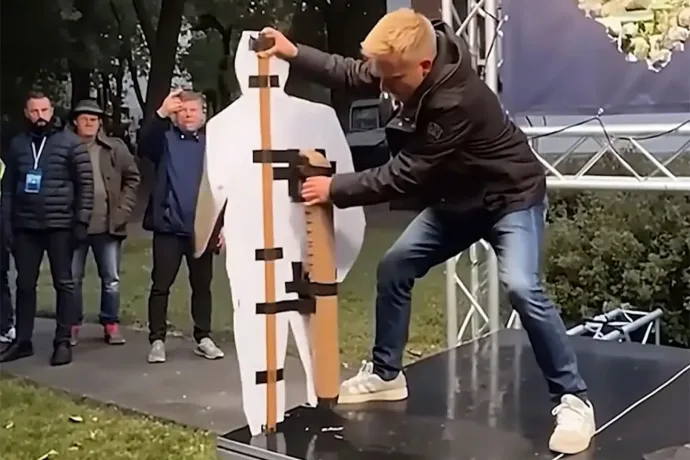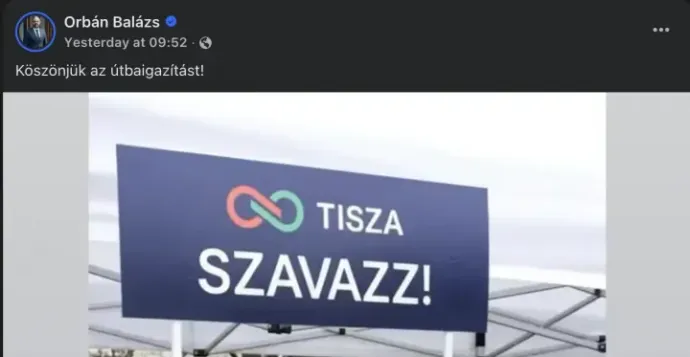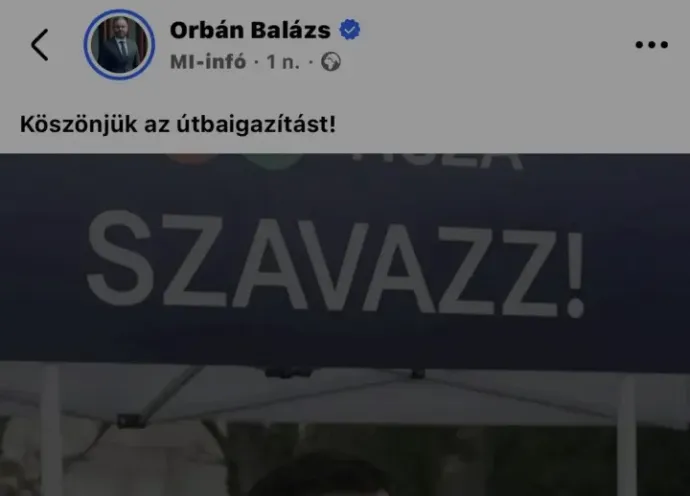Fidesz's campaign levels up: here's how they are using AI-generated fake videos to dismantle reality one brick at a time

A whole lot can change in the space of a few months, especially in a political campaign. A few months ago, László Palkovics, the Hungarian government's Commissioner responsible for Artificial Intelligence said that technology had no place in a campaign, and Balázs Németh, the host of Harcosok órája (Warriors’ Hour – a daily, one-hour long interview programme) and the spokesperson of the Fidesz faction, expressed his outrage about the internet being flooded with AI-generated fake videos with political content. As we reported at the time, despite these opinions, Fidesz and AI were already bringing out the worst in each other.
Since then, however, Fidesz and the organizations in its orbit have stepped up their distribution of fake videos, and they are not always doing it in the most responsible fashion — if such a thing as responsible AI video generation even exists.
Six months before the country's next parliamentary elections, Hungary's ruling party has arrived at a point where they have not only failed to indicate that they had inserted AI-generated footage into a video posted on Facebook, but the video was edited in such a way as to make the inserted footage appear real.
The reason why this is particularly worrying and why it represents a step up from previous incidents is because for the video in question, the images were not generated out of thin air. Instead, artificial intelligence was used to modify an event that had actually taken place, thereby blurring the line between reality and fiction even further.
Although this summer Balázs Németh was still utterly opposed to AI, he now appears to have embraced using the technology. A few days ago on his Harcosok órája programme, while interviewing Boglárka Futó, a journalist of pro-government Hír TV about Péter Magyar, he announced with a smile that he would like to play an AI-generated video about Fidesz's challenger next. The generated video is based on a real event, namely that for some of their recent rallies, the president of the Tisza Party took a life-sized cardboard cutout of Viktor Orbán on stage with him. The real video of one such occasion was supplemented by adding a sequence of AI-generated images in which Magyar is shown smashing the cardboard cutout near the edge of the stage, acting like a madman.
Balázs Németh at least announced in advance that he would not be showing an actual recording. This was not the case with the Fidesz faction though. They shared the excerpt from the programme on their own website and only added the comment that “Péter Magyar's nerves are wearing thin.”
There was one small difference though: they edited the video to the point where it is not evident that it is fake, and it seems as if Futó and Németh are discussing this specific recording after it was shown:
All of this was done without any indication that artificial intelligence had anything to do with the video, which is not too much to ask – especially given that the faction's spokesperson, Balázs Németh had previously expressed his fears about this exact possibility.
Balázs Orbán, the Prime Minister's political director, did the same thing. Similarly to his boss, he likes to share AI-generated videos. The most recent one for example featured a Tisza Party activist sending people over to Fidesz's booth, and away from their own. However, the way he posted this video on his page doesn’t make it apparent from the browser that it is AI-generated content. Incidentally, the video is of misleadingly high quality: it is mostly the sounds that give it away as unnatural, but if one is not familiar with the peculiarities of AI videos (such as the inaccurate mouth movements, the strange fluid movements, objects sliding over each other, or bizarre letters), one could easily believe that the video is real.
There is even a label indicating that the audio is original, which really just means that the audio was not taken from another video, but this could easily be misleading as well. Especially for someone not familiar with all the ins and outs of Facebook, it might imply that the conversation heard in the video was actually recorded in real life. Although the person uploading the content may indicate if the video was AI-generated, in the case of Balázs Orbán's post, this was only partially successful. When we asked him – among other things – why the video was not labelled as AI-generated, as shown in the first image below, the Communications Department of the Political Director's Office sent a screenshot showing that they had indeed indicated that the video was not real, and also sent an accompanying image:


As it turns out, the small "MI-infó" (MI=AI in Hungarian) label is only visible when viewing the post in the mobile app. As for our other questions, we have not yet received answers.
Gergely Gulyás, Minister of the Prime Minister's Office is operating in a similar fashion, albeit much more appropriately: he recently appeared on Hír TV's programme, "Monitor", where he, among other things spoke about Péter Magyar's comments on social media, and an edited video of this was later posted on his own Facebook page. In it, presenter Róbert M. Kovács first talks about how he thinks the President of the Tisza Party has lost his mind, and then they cut to an AI-generated video of Magyar raging in front of a computer. In this case, however, the creator at least burned the term "AI-generated video" onto the frames.
We have sent questions about the videos to both Fidesz and Balázs Orbán, and will report back if we receive a substantive response.
Nemzeti Ellenállás Mozgalom (National Resistance Movement), which has been spending hundreds of millions of forints on advertising and which was recently acquired by the owner of Megafon, is also a big fan of AI videos. They had recently made a video (using AI) about Péter Magyar whistling a tune while floating down the Tisza River in a bathtub, which the public media liked so much that in September they even included an excerpt from it in the news. The segment in which a non-existent reporter is interviewing a non-existent person in a non-existent place about the supposed tax increase the Tisza party would introduce if they came to power was included in the programme without any indication that the whole thing had been generated by AI.
It is evident that Fidesz is no longer afraid of AI, which is not really surprising. Having lost one of their biggest campaign weapons with online political advertising in the EU shut down, it is only natural that they are trying to find new instruments. The problem with this is that AI is destroying our shared reality. Once it becomes possible to produce realistic video ‘evidence’ about anything—regardless of whether it had actually happened or not—the truthfulness of everything will be called into question. And the truth is that we are already at a point where several Fidesz politicians are not even indicating that they are posting fake videos. With six months left until the elections, there's no telling what else might await us in the coming months of the campaign.
For more quick, accurate and impartial news from and about Hungary, subscribe to the Telex English newsletter!